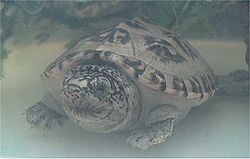This article needs additional citations for verification .(December 2018) |
| Mexican musk turtle | |
|---|---|
 | |
| Staurotypus triporcatus | |
| Scientific classification | |
| Domain: | Eukaryota |
| Kingdom: | Animalia |
| Phylum: | Chordata |
| Class: | Reptilia |
| Order: | Testudines |
| Suborder: | Cryptodira |
| Family: | Kinosternidae |
| Genus: | Staurotypus |
| Species: | S. triporcatus |
| Binomial name | |
| Staurotypus triporcatus (Wiegmann, 1828) | |
| Synonyms [2] | |
| |
The Mexican musk turtle (Staurotypus triporcatus), also known commonly as the giant musk turtle, is a species of turtle in the family Kinosternidae. The species occurs in Central America and Mexico.
